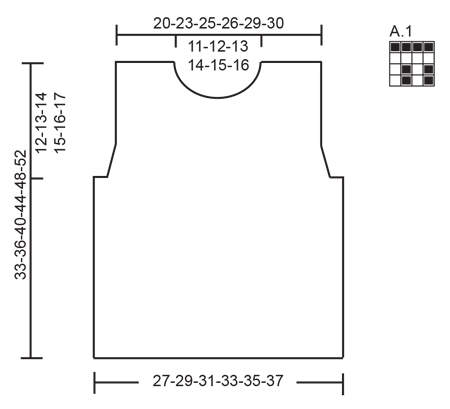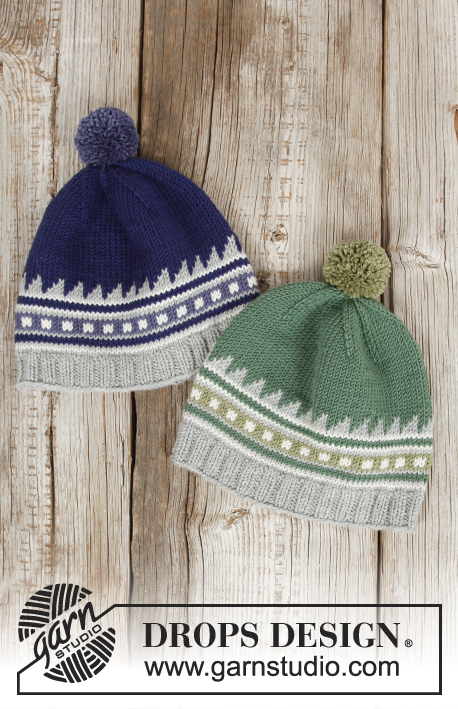Comments / Questions (36)
![]() Leena wrote:
Leena wrote:
Missä ohje?
03.01.2025 - 18:09DROPS Design answered:
Ohje avautuu, kun klikkaat kuvaa suomenkielisillä sivuilla.
03.01.2025 - 18:20
![]() Susan wrote:
Susan wrote:
I greatly appreciate your free patterns. I am a relative newbie and am a bit confused by how to make the armholes. Do you have a video on this. Sorry, if you do. I couldn't find it. Thanks so much
17.09.2024 - 07:50DROPS Design answered:
Dear Susan, you work body in the round to the armholes, then you cast off 7 sts on each side and continue front and back piece separately back and forth. You first work 3 rows (starting from WS) then start decrease on each side after the first 3 sts and before the last 3 sts (see DECREASE TIP a total of 4 times on every 4th row (= on every other row from RS). Happy knitting!
17.09.2024 - 09:11
![]() Pauline Northrop wrote:
Pauline Northrop wrote:
Where are the instructions for picking up sts to knit the rib around the armholes for this vest is best pattern
19.08.2024 - 06:36DROPS Design answered:
Dear Pauline, you can see video-tutorial here . A list of related videos can be found next to each pattern, just below the title. Happy knitting!
19.08.2024 - 06:42
![]() Pernille Terp wrote:
Pernille Terp wrote:
Man skal strikke 4 pind ret over 13 masker, men efterfølgende skal man lukke 14 masker. Hvordan passer det sammen?
30.07.2024 - 22:35DROPS Design answered:
Hej Pernille, du lukker kun 7 masker af under hvert ærme (så du får 3 retstrikkede kantmasker i hver side) :)
02.08.2024 - 10:58
![]() Pernille Terp wrote:
Pernille Terp wrote:
Hvorfor skal der strikkes 4 pind ret over de midterste 13 masker? Skulle det ikke være vrang, så det passer med rib i ærmegab?
30.07.2024 - 22:30
![]() Heather wrote:
Heather wrote:
I am having a problem reading the pattern. Where it says over the middle 13 sts. Should I do this for both markers otherwise how do I bind off 7 sts twice
07.09.2023 - 21:10DROPS Design answered:
Dear Heather, you will work 13 stitches in garter stitch on each side of body (for armhole edge), this means you will work 13 sts (= 6 sts before the stitch with the marker + the stitch with the marker + the 6 sts after this stitch) on each side in garter stitch; after 2 ridges over these 13 sts (work the remaining stitches as before), you will cast off the middle 7 sts for armhole and divide piece (3 sts in garter stitch remain for each armhole edge). Happy knitting!
08.09.2023 - 08:06
![]() Rita Roy Chowdhury wrote:
Rita Roy Chowdhury wrote:
Please let me know if this can be done with straight needles. Not comfortable with circular needles. Waiting to knit this for my grandson. Rita India
14.08.2022 - 13:54DROPS Design answered:
Dear Rita, you can adapt this pattern to straight needles; see how to do this in the following link: https://www.garnstudio.com/lesson.php?id=13&cid=19. Happy knitting!
14.08.2022 - 22:08
![]() Sylvie wrote:
Sylvie wrote:
Quand je rabat les treize mailles pour les emmanchures où les marqueurs de chaque coté, je n’arrive pas au même nombre de mailles que vous soit 57 de chaque coté. Si au départ on a 128 mailles on enlève 13 mailles de chaque coté il reste 102 soit 51 maille de chaque coté. Pouvez-vous m’aider svp
13.04.2022 - 03:42
![]() Maria wrote:
Maria wrote:
Grazie mille, sei sempre gentilissimi e velocissimi nella risposta.
06.02.2022 - 11:36
![]() Maria wrote:
Maria wrote:
Buongiorno, sto lavorando in tondo questo modello, ma non riesco ad interpretare correttamente la legenda del diagramma, cosa significa la virgola messa nella descrizione dei punti dello schema? Bisogna fare un giro con la prima parte a sinistra della virgola e poi nel giro successivo fare la parte a destra? Io ho provato così ma non mi sembra corretto il punto che realizzo. symbols = 1 m dir sul diritto, rov sul rovescio symbols = 1 m rov sul diritto, dir sul rovescio
05.02.2022 - 13:39DROPS Design answered:
Buonasera Maria, la virgola serve a differenziare il lavoro a seconda se si lavori sul diritto o rovescio del lavoro. Se sta lavorando in tondo è come se stesse sempre lavorando sul diritto del lavoro. Buon lavoro!
05.02.2022 - 19:18
Vest is Best!#vestisbest |
|||||||
 |
 |
||||||
Knitted vest with textured pattern in DROPS Cotton Merino. Size children 2 - 12 years
DROPS Children 27-26 |
|||||||
|
GARTER ST (worked in the round): 1 ridge = 2 rounds. * K 1 round and P 1 round *, repeat from *-*. GARTER ST (back and forth): K all rows. 1 ridge = K2 rows. PATTERN: See diagram A.1. DECREASE TIP (applies to armhole): Dec 1 st inside 3 edge sts in garter st in each side. All dec are done from RS! Dec as follows after 3 edge sts in garter st: Slip 1 st as if to K, K 1, psso. Dec as follows before 3 edge sts in garter st: Beg 2 sts before the 3 edge sts and K 2 tog. ---------------------------------------------------------- VEST: Piece is worked in the round on circular needle up to armhole, then finish front and back piece back and forth on circular needle. BODY: Cast on 128-140-148-156-168-176 sts on circular needle size 3 mm / US 2.5 with Cotton Merino. Work 2 ridges in GARTER ST - see explanation above. Switch to circular needle size 3.5 mm / US 4 and K 1 round. Insert 1 marker in first st on round and 1 marker in 65th-71st-75th-79th-85th-89th st on round (= in the sides – there are now 63-69-73-77-83-87 sts between sts with markers). Then work pattern in the round according to diagram A.1 (markers are in a P st in pattern). REMEMBER THE KNITTING GAUGE When piece measures 20-22-25-28-31-34 cm / 8"-8 3/4"-9 3/4"-11"-12 1/4"-13½", work 2 ridges in garter st over the middle 13 sts in each side (i.e. over st with marker + 6 sts on each side of this – work the other sts as before). On first round after ridges, bind off the middle 7 sts in each side for armhole and finish front and back piece separately. BACK PIECE: = 57-63-67-71-77-81 sts. Continue with pattern back and forth with 3 edge sts in garter st in each side (1st row = WS). When 3 rows have been worked back and forth, dec on next row from RS for armhole in each side - READ DECREASE TIP (= 2 sts dec). Dec like this every 4th row (i.e. every other row from RS), 4 times in total = 49-55-59-63-69-73 sts. Continue pattern with 3 edge sts in garter st in each side until piece measures 31-34-38-42-46-50 cm / 12 1/4"-13½"-15"-16½"-18"-19 3/4". Now bind off the middle 25-27-29-31-33-37 sts for neck and finish each shoulder separately. Bind off 1 st on next row from neck = 11-13-14-15-17-17 sts remain on the shoulder. Work until 2 rows remain before piece measures 33-36-40-44-48-52 cm / 13"-14 1/4"-15 3/4"-17 1/4"-19"-20½", adjust so that next row is worked from RS. K 1 row from RS and K 1 row from WS and then bind off with K from RS. Repeat on the other shoulder. FRONT PIECE: = 57-63-67-71-77-81 sts. Work as back piece and bind off for armhole in the sides as on back piece = 49-55-59-63-69-73 sts. When piece measures 28-31-34-38-41-45 cm / 11"-12 1/4"-13½"-15"-16"-17 3/4", slip the middle 15-17-17-17-17-19 sts on 1 stitch holder for neck and finish each shoulder separately. Continue to bind off for neck at beg of every row from neck as follows: bind off 2 sts 2-2-2-2-3-3 times and 1 st 2-2-3-4-3-4 times = 11-13-14-15-17-17 sts remain on shoulder. Work until 2 row remains before piece measures 33-36-40-44-48-52 cm / "-14 1/4"-15 3/4"-17 1/4"-19"-20½" - adjust according to back piece. K 1 row from RS and K 1 row from WS and then bind off with K from RS. Repeat on the other shoulder. ASSEMBLY: Sew shoulder seams inside bind-off edge. NECK EDGE: Pick up from RS approx. 66-70-78-82-88-94 sts around the neck (includes sts on stitch holder at the front) on a short circular needle size 3 mm / US 2.5. P 1 round, K 1 round and P 1 round. Then loosely bind off with K. |
|||||||
Diagram explanations |
|||||||
|
|||||||

|
|||||||
Have you finished this pattern?Tag your pictures with #dropspattern #vestisbest or submit them to the #dropsfan gallery. Do you need help with this pattern?You'll find 20 tutorial videos, a Comments/Questions area and more by visiting the pattern on garnstudio.com. © 1982-2025 DROPS Design A/S. We reserve all rights. This document, including all its sub-sections, has copyrights. Read more about what you can do with our patterns at the bottom of each pattern on our site. |
|||||||





























































Post a comment to pattern DROPS Children 27-26
We would love to hear what you have to say about this pattern!
If you want to leave a question, please make sure you select the correct category in the form below, to speed up the answering process. Required fields are marked *.